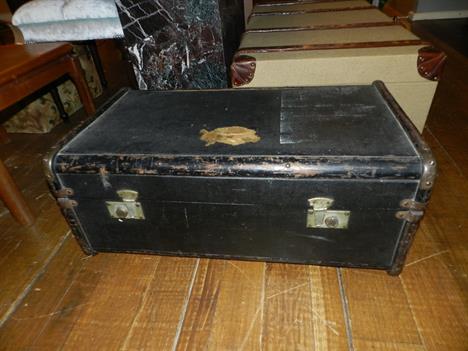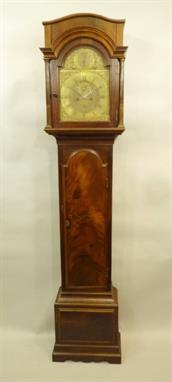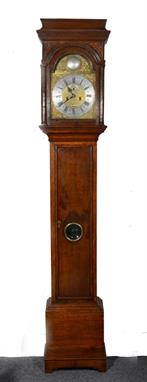We found 66887 price guide item(s) matching your search
There are 66887 lots that match your search criteria. Subscribe now to get instant access to the full price guide service.
Click here to subscribe- List
- Grid
-
66887 item(s)/page
VICTORIAN EIGHT DAY MAHOGANY LONGCASE CLOCK the arched enamel dial painted with a regency figure of a lady, Roman numerals, subsidiary seconds and date dials, the hood with swan neck pediment above a trunk and pedestal base on bracket feet, 216cm high Some veneer missing from pedestal. small chip to front corner of cornice. No makers name. one spoke of paterae to side of hood missing.
An 18th Century Japanned Longcase Clock with eight day movement. The 13 inch (33 cm) brass dial having a painted moon roller in the arch above the chapter ring encircling a matted centre with calendar aperture and seconds ring. The corners adorned with figural spandrels representing the seasons in engraved borders. The case decorated with Chinoiserie figures and scenes depicted in raised gilt lacquered on a dark green ground. The hood with caddy top and turned columns flanking the dial. The trunk with a break dome top door and moulded base, 94 ins (129 cms) in height.
A George III Oak & Mahogany Cross-banded Eight Day Long-case Clock (A/F). The painted 12 inch (30.5 cm) dial having an oval portrait medallion in the arch depicting a young girl with garland of flowers, fanned motifs to the corners and subsidiary calendar and seconds dials to the centre. The hood with a pagoda pediment surmounted by spired brass ball finials and having fluted columns flanking the dial. The lip moulded trunk door inlaid with a conch shell in a navette shaped panel flanked by canted sides and standing on a moulded base with bracket feet, 93 ins (236 cms) overall in height.
A 19th Century Red Stoneware Treacle Glazed Halifax Inkstand, modelled in the form of a tree trunk on organic base with yellow birds perched amongst the branches, a pair of nesting birds forming the inkwells, and a pen-rest edged in twisted bands, 5 ins (13 cms) in height, 8 ins x 7½ ins (20 cms x 19 cms).
EDWARD PISTOR, LONDON A PART 18TH/19TH CENTURY MAHOGANY LONGCASE CLOCK, having shaped hood with blind fret carving and flank pilasters, Victorian 8-day mechanism with anchor escapement faced by a period brass dial with strike silent calendar, second"" s, spandrels, flame veneered trunk and base, 2.25m high, including two weights, pendulum and key
A Victorian Royal Navy bicorn hat by George Spencer of Portsmouth with gilt braid and epaulettes, the Royal Naval silvered insignia on a gold braid background, together with a World War I Submariner sword belt, all contained within a japanned tin trunk CONDITION REPORTS Box with quite a lot of wear and scuffs, rusting, some losses to decoration, some sellotape/parcel tape remnants, various scratches, lock snapped and broken, pocket to interior with curling and tears, there is some evidence that moths have got into the box at some stage, although moth damage to the items does not appear to be particularly obvious. Belt with quite a lot of wear and scuffs to leather, some cracking, etc. Braid covered belt with some general wear and dirt, but overall condition appears reasonable. Gilt accessories with some fraying and losses. Hat with general wear, scuffs, some dirt and stains (please see photos), epaulettes appear to have had new felt pads sewn to the underside (please see photos).
A late 19th Century Mauchline ware diminutive trunk with cord handles, the domed lid decorated with a titled scene of `Burns` Cottage`, above a rectangular base inscribed `Bought in the Cottage` and a verse, length approx 8.3cm, a late 19th Century Mauchline ware spinning top, decorated with a titled view of `Mauchlin From Mauchlin Hill` and a verse, diameter approx 8cm, and a pair of Mauchline ware vases, one decorated with `Burns` Monument`, the other with `Interior of Burns` Cottage`, height approx 16cm.
A Chinese doucai porcelain bowl, mark of Chenghua but possibly late 19th Century, the exterior painted with a continuous scene of a monkey seated on the trunk of a peach tree, beside a deer, insects, birds and flowering plants, pseudo six character mark in underglaze blue to base, diameter approx 17.7cm, with wood stand.
A Chinese carved rootwood brushpot, late Qing dynasty, the gnarled trunk carved in low relief with a pair of chequer players, another figure and various auspicious animals, including 3-legged toads, hare, owl, bat and rat, beneath tree branches, carved inscription to base including indistinct date, possibly 1877, height approx 12.5cm.
Samuel Shepley, Stockport, a George III oak eight day longcase clock, circa 1750-70, the 12" brass dial with silvered chapter, date aperture and subsidiary seconds, signed, applied with pierced spandrels cast with the bust of an Eastern man, the hood with caddy top and turned columns, the trunk with a long crossbanded door, the base raised on bracket feet. 220cm
Thomas Arlot, Sunderland (1765-91), a George III oak eight day longcase clock, the 12" brass break arch dial with subsidiary seconds and date dial, engraved with scrolling vine, signed in the arch, the hood with broken pediment and brass sphere finial, Corinthian columns, the case with long trunk door, with weights and pendulum. 234cm
C18th/C19th Mahogany Long Case Clock on small bracket supports with box wood & ebony stringing, domed trunk door, domed hood with fluted pillars encasing brass dial, brass chapter ring with Roman numerals, painted metal pierced hands, dome mounted with scrolling fish & Tempus Fugit, musical Westminster chiming German replacement, 1930`s movement, striking on bars, with triple weights, full size pendulum
A good 18th century mahogany eight day long case clock, the brass dial signed J.N.O. Pitts, Tilbury, beneath an ornate, cherub, arch, the case with blind fret, canted corners beneath a fret pierced and flowerhead carved pediment, the whole on ogee bracket feet, maximum height 244cm. Condition Report: We do not operate the clocks to see if in working order and do not guarantee the workings. There are three holes drilled into the brass dial where the movement posts are connected therefore uncertain if the movement is original. The seating boards are built up. The edge of the trunk door has some damage together with the back legs missing.
A Victorian Royal Worcester blush ivory vase modelled as a Caparisond Elephant, painted in brown, turquoise and green shot enamels with gilded highlights, puce painted mark, impressed mark and registration lozenge, date mark for 1878, height 20cm. Condition Report: Slight wear to gilding on top. Both tusks have been restored as has the lower half of the trunk.
1901-19 [Lot of 4] Clason`s Guide Map of Arizona [and] Territory of Arizona [and] Arizona [and] Arizona. Sketch Map of Irrigated Areas and Main Topographic Features ""A. Clason`s Guide Map of Arizona, by Clason Map Company, dated 1919, printed color (15.0 x 17.6""""). This folding pocket map is complete with descriptive booklet, """"Clason`s Arizona Road Map and Railway Guide"""" (4 x 6.3""""). The map delineates early Automobile Roads and Main Automobile Roads via red overprinted lines. The legend also locates the state capital (Phoenix), counties lines, county seats, railroads, rail trunk lines, Indian reservations, and National Forests. Below the map is a list of towns with populations: Phoenix had just over 30,000 people, a number that stayed small until air conditioning came into commercial use. The map shows Greenlee County, created from part of Graham County in 1909. Folds into paper covers with 24-page booklet which includes full-page city plans of Tucson and Phoenix. Condition: A clean and bright example. (A) B. Territory of Arizona, by General Land Office, dated 1901, printed color (16.9 x 20.2""""). A colorful and fascinating map with great detail issued eleven years before statehood. The extent of nine Indian reservations and at least three Military reservations, including Camp Apache, are clearly shown in different colors. Numerous confirmed and unconfirmed land claims are named and located. A huge Grand Canyon Forest Reserve is shown. The brown hachured mountain area and the blue waterways combine to provide great visual impact. Information includes watershed, mountains, railroads, wagon roads, private claims, unsurveyed townships, etc. A beautiful example published while Harry King was the Chief of Drafting and the Hon. Binger Hermann was commissioner. Condition: Fine. (A+) C. Arizona, by U.S.G.S, circa 1902, black and white (18.4 x 21.7""""). This uncommon map accompanied the 1902 congressional report on preparations for Arizona statehood. It shows the areas that could and could not support population with the vast majority of land deemed """"open to entry, but not capable of supporting population."""" Condition: A clean sheet with one tiny split at a fold intersection and a slightly narrow left margin due to binding trim. (A) D. Arizona. Sketch Map of Irrigated Areas and Main Topographic Features, from Report of Governor of Arizona, dated 1901, black and white (6.4 x 9.0""""). Smaller and more basic map as above, showing the irrigated areas of the state. Condition: Fine. (A+)"" "" W x "" H See descriptions above.
-
66887 item(s)/page





















































![1901-19 [Lot of 4] Clason`s Guide Map of Arizona [and] Territory of Arizona [and] Arizona [and] Arizona. Sketch Map of Irrig](http://lot-images.atgmedia.com/SR/36385/2901770/235-201425154034_468x382.jpg)


